Odds & Ends: Ixalan, Part 2
Last week I started my mailbag column about Ixalan. There were so many great questions that today I'm answering more in Part 2.
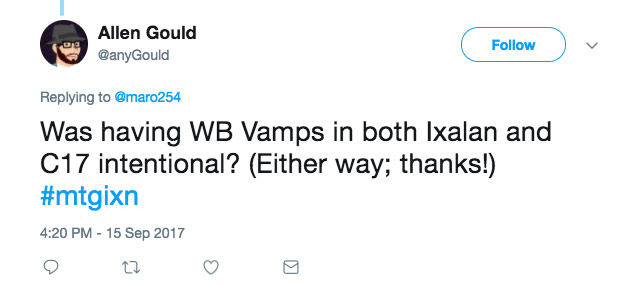
It was absolutely intentional. One of the things we're always on the lookout for is synergy between different products. When Gavin Verhey and his team were designing Commander (2017 Edition), they realized early on that they were interested in making tribal decks, so they looked around to figure out which popular tribes were missing something, especially a good commander.
Vampires had an interesting Commander problem. On Innistrad, Vampires are black and red, and on Ixalan, they're black and white. That meant there would be desire for a red-black-white legendary Vampire lord, but it wasn't something that either an Innistrad set or an Ixalan set could provide, making it a perfect candidate for Commander 2017.
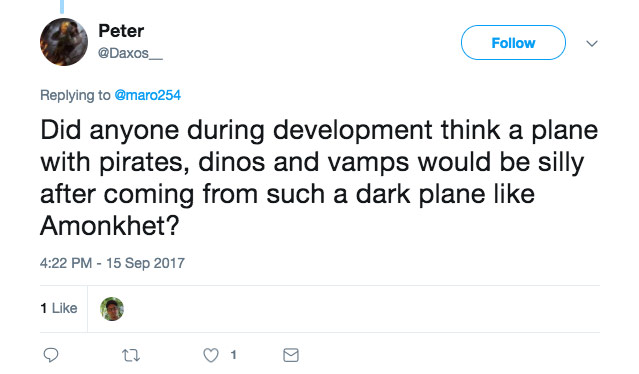
It was the exact opposite, actually. One of the things we like to do is "swing the pendulum" and give back-to-back Magic sets very different feels. That way if players don't like a particular setting, they don't have to wait long for something different. In fact, one of the big reasons for Magic's success and the thing, I believe, that most contributes to why our average player plays for so long is the flux built into the game. You don't get tired of Magic because it's constantly changing.
We knew that Amonkhet block was going to have a more serious tone, one where we got to see a major villain have a big win against our heroes. It was important that the following block was a little lighter, that it balanced the tone. So not only weren't we worried, we did it on purpose.
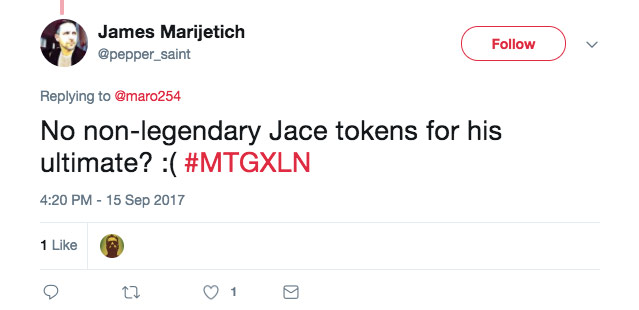
Jace, Cunning Castaway's ultimate creates a token that's a copy of himself. Normally, we make token cards for all of our tokens. Why didn't we make one for Jace's copies? The answer is we normally don't make token cards for tokens that are copies of the card that creates them. For example, there was no token copy for Return to Ravnica's Pack Rat.
The major reason we don't make these is that they cause confusion. Technically, the copies have all the attributes, including the mana cost, which makes the token copies look a lot like actual cards. As a general rule, we avoid printing them.
But wait, didn't we just make a whole bunch of token copies in Amonkhet and Hour of Devastation for the embalm and eternalize mechanics, respectively? We did as those were major mechanics of the set and we had an interesting creative treatment we were wanted to do for the tokens. Also, because it was a mechanic, we could build into it the fact that the tokens didn't have mana costs.
Is this a rule we should change? I'm curious to hear what all of you think about it?
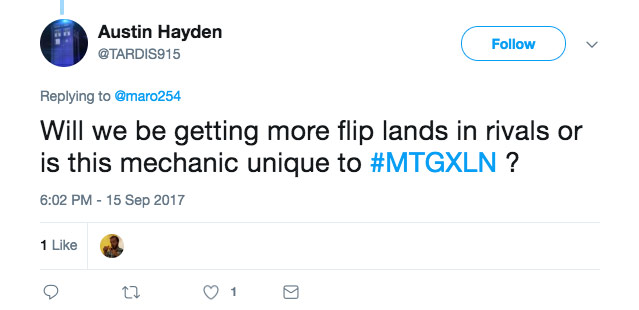
Double-faced cards ("flip" cards are technically something we did in Champions of Kamigawa block where the card could flip upside down and change into a different form; it was the precursor to double-faced cards) are an Ixalan block thing and not just an Ixalan set thing, so yes, there will be double-faced cards in Rivals of Ixalan. Will they be exactly the same? You'll have to wait and see.
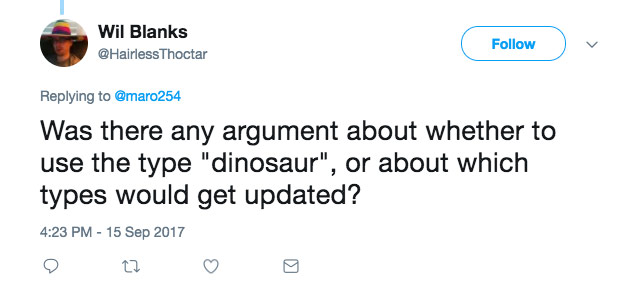
There was actually a big argument about whether or not we should introduce "Dinosaur" as a new creature type. With huge dramatic license, here's my take on the argument (note that I was the loudest advocate for the pro side):
Con: Tribal themes are very popular. If we make too many creature types, we dilute the pool and make it harder for players to build decks.
Pro: There must to be reasons to create new tribes. Magic constantly adds new mechanics; it seems wrong that it would never add new creature types.
Con: Yes, it should when they don't fit into the system we currently have.
Pro: How about something splashy enough that it excites players?
Con: That's a slippery slope. You can always subdivide categories into cool subcategories. But do that often enough and there's not enough cards to build tribal decks.
Pro: Of course, the bar should be high, but some things can still clear it. Like say Dinosaurs.
Con: I'm not saying you can't create Dinosaurs. They'll have cool Dinosaur art and cool Dinosaur names. You just don't need the creature type line to read "Dinosaur."
Pro: What would you put there?
Con: Lizard. It's what we've used when we made Dinosaurs in the past.
Pro: Not originally. Way back when, they were actually Dinosaurs.
Con: And we changed it.
Pro: Because there weren't enough of them. With Ixalan, that won't be true anymore.
Con: But tying them to Lizards just gives the players more choices for the deck.
Pro: Modern science isn't even sure dinosaurs were lizards. They might have been birds.
Con: Then make them Birds. That's also a supported creature type.
Pro: Birds that mostly don't fly?
Con: Just tie them to something already established.
Pro: Why? Players are going to be excited for Dinosaur decks. Why not let them make actual Dinosaur decks?
Con: It sets a precedent that if left unchecked will cause us problems down the road. For example, many of us already regret doing Naga instead of Snake.
Pro: Yes, we should learn from Naga. We have to be careful where we set the bar, but no matter how high we set it, if anything could clear it, it would be Dinosaurs. How many creature types have a whole movie franchise?
Con: Pirates, Constructs, Apes, Gremlins, Minions.
Pro: Okay, you've convinced me we should bring back Minions.
Obviously in the end, the Dinosaur side won. It was the much bigger side, by the way.
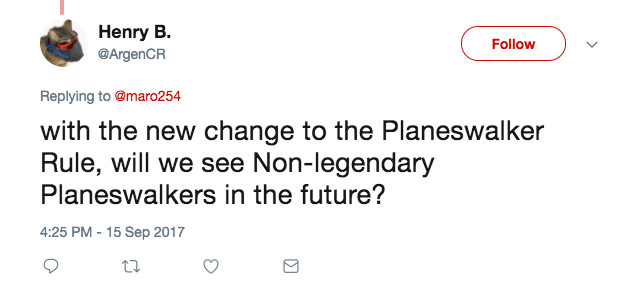
There's no current plan to do that. We made planeswalkers legendary to consolidate two rules that were similar but slightly different (the planeswalker uniqueness rule and the legendary supertype rule). Making non-legendary planeswalkers would confuse players as the card type wouldn't play consistently the same and would create flavor dissonance as planeswalking is a special and super-rare thing. We're not interested in generic no-name Planeswalkers.
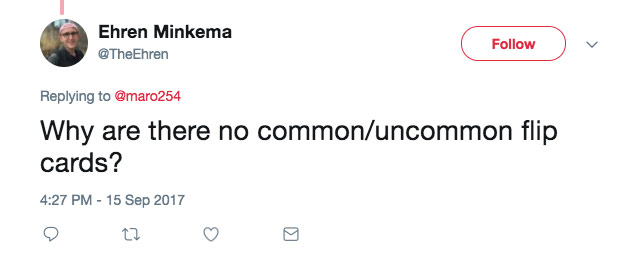
Usually when we design to a new mechanic (and yes, technically transform is not new, but this style of double-faced cards is new), the rule is to not limit what we design and just see where the cards end up. If the mechanic lends itself well to common, we'll end up making some common designs. If it leans more rare, we'll end up making more rare cards. The idea is to let the mechanic's design space lead the designs.
We did try designing some uncommon cards, but they ended up feeling more rare, so we moved them up in rarity. Here's what I believe is going on. The Ixalan double-faced cards are what I call mission cards. Each card gives you something you have to accomplish and then rewards you for accomplishing it. That means the front side is going to be a bit wordy, as it has to define the mission.
The back can be a bit simpler as the reward is more about power or novelty than its about complexity, but it has to be splashy enough to make the mission worthwhile. The need for splash tends to also push us up in rarity. For example, most of the iconic land cards that inspired the backsides of the Ixalan double-faced cards are themselves rare.
So, the front is complex and the back is splashy. Both individually push up the rarity of the card, and then being on the same card together pushes it up even more. And that is why there are no common or uncommon Ixalan double-faced cards.

It was definitely something we were watching out for. The big difference we drew was where the source of conflict came from. On Zendikar, the conflicts are mostly people against environment. The world is dangerous and the inhabitants are trying to do whatever it is they're trying to do without being killed by the world. On Ixalan, the conflicts are mostly people against people (and when I say "people" in Magic, I mean all the various sapient creatures). The land itself is pretty benign. It's a thing to explore, not a thing that you battle against. The two are also playing into different trope space. Zendikar taps into adventure parties and dungeon crawls, things like Dungeons & Dragons. Ixalan, in contrast, is playing around with lost world and pirate tropes, stuff pulled from old pulp novels. So, while the two have some similarities, they also have some stark differences.
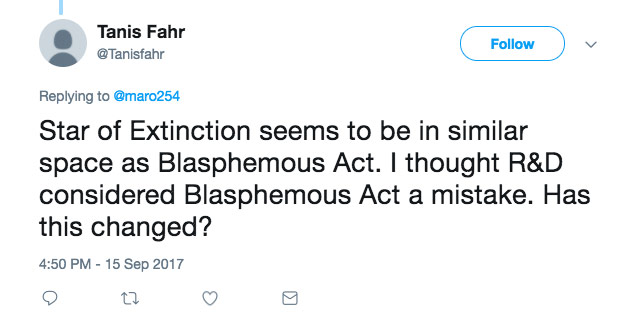
Star of Extinction is a bleed in red. Normally, we try to limit how much damage red deals to creatures to make toughness mean something. Black, in contrast, is the color that destroys creatures regardless of size. When you start dealing damage of 7 or more, you get to the point where the card essentially functions as if it says "destroy target creature." We like maintaining the difference, as black and red are one of the two-color pairs that most overlap (green and white being the other pair) and, thus, need more mechanical separation.
It's not that red isn't allowed to deal a lot of damage. It has cards like Fireball, for instance. We just try to make sure that when red is dealing extra damage, it's something it pays for. The fact that Star of Extinction costs seven mana to use is definitely one of the things that led us to allow the bleed.
The other big factor is flavor. One of the places we're mostly like to bend the color pie (in contrast to breaking it, by the way, which is when a color is undercutting its own weakness) is when we have a very evocative and flavorful card, as we do with Star of Extinction. (Dinosaur tropes, it turns out, are not quite as plentiful as Pirate tropes.) This is not something I want red doing often, but as an infrequent, high-costed, flavor home run, I feel it's acceptable in this particular case.
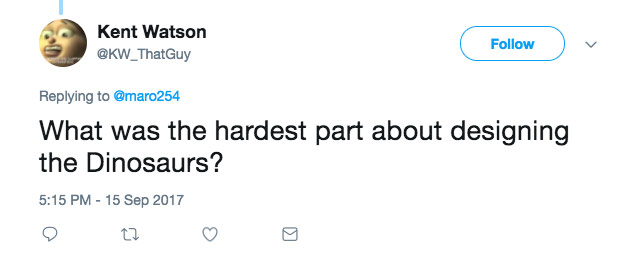
I think the best way to demonstrate the difference is to compare Dinosaurs with Pirates. When you think of Pirates, what do you think of them doing? They can fight and bury treasure and search for treasure and ransack and torture and party and use weapons from cutlasses to cannons. There's just an endless list of Pirate activities. In contrast, what do Dinosaurs do?
They growl. They can run. They can attack. It's not a particularly long list. Also, it's mostly tied to aggression. Yes, they make sense as bigger creatures that attack and block, but what else can they do mechanically? They can have a few combat-related mechanics, they can have attack triggers, they can have dealing-damage triggers. It just all plays in a very narrow band of what creature can do.
Making simple vanilla and French vanilla Dinosaurs was easy. Making Dinosaurs that were more complex and captured some flavor aspect, while still feeling like a Dinosaur, was a lot harder.
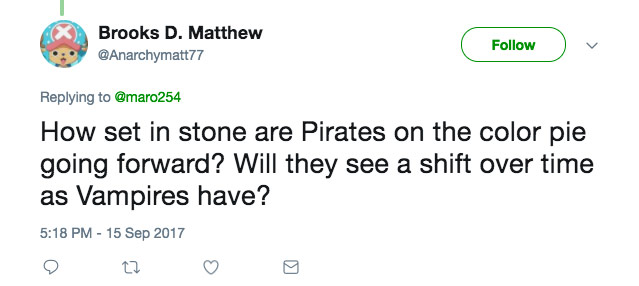
One of the things I've learned making Magic over the years is that there are things you never expect until the day you make them. Had you asked me a decade ago if we'd ever make white Zombies, I would've probably said no, but I remember designing Amonkhet and it being obvious that they're had to be white mummies.
So, do I expect there to be white or green Pirates? No, I'm not sure what flavor justification would make either of those two choices make sense. That said, we're visiting a lot of new worlds in Magic's future, and it would be arrogant of me to assume that I definitively know that none of them could possibly have white or green Pirates.
The one thing I can say is that if Ixalan proves to be popular, it will increase the likelihood of us doing more Pirates, which would, in turn, increase the chances of a white or green Pirate one day existing. All that said, it doesn't seem super likely.
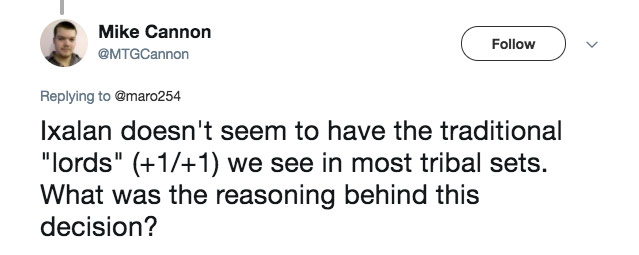
One of the tricky things about tribal design is that you want to give each tribe its own mechanical feel without having the different tribes appear too similar to one another. As such, we were careful to differentiate between the mechanical execution of the four tribes in Ixalan, especially on their lords (creatures that grant one or more abilities or stat boosts to all of a certain creature type or types).
That said, both Pirates and Dinosaurs do have a creature that grants other creatures of its kind +1/+1 (Admiral Beckett Brass and Thundering Spineback, respectively). Pirates also have a Ship that grants Pirates +1/+0 (Fell Flagship). Vampires and Merfolk, on the other hand, weren't given a traditional +1/+1 lords to help them play differently. A secondary reason for this is that Vampires and Merfolk both have lords from earlier sets in the game for casual tribal play.
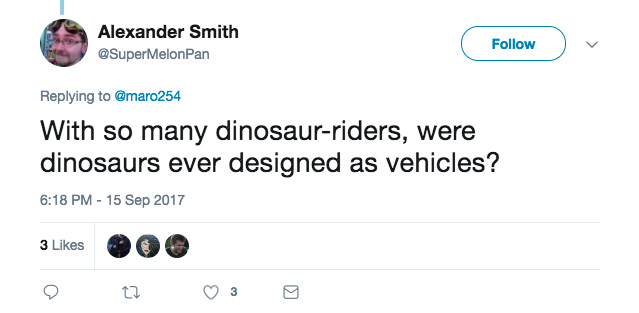
When we were making the rules for Vehicles during Kaladesh, I brought up what I call the "mount issue." Yes, riding in artificially made Vehicles is a lot of fun, but so too is riding creatures. Someday I knew we'd want to explore the mount mechanical space, so I was curious if we wanted to write the rules for Vehicles such that one day we could use them for Mounts.
The rules manager at the time, Matt Tabak, explained to me it wasn't possible, as Vehicles by design aren't creatures until crewed. Mounts, by flavor, are always creatures, so the mechanical execution wouldn't work. This is also why when choosing the words "Vehicle" and "crew," we leaned toward the mechanical side of the flavor.
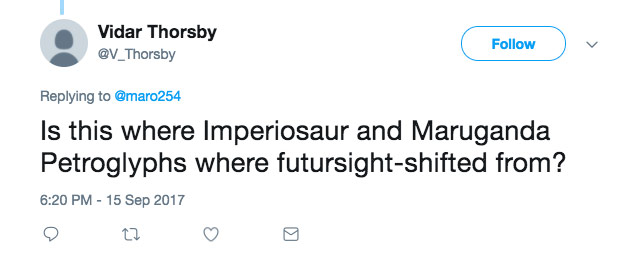
The answer is no. The flavor text of Imperiosaur and the name of Muraganda Petroglyphs place both cards on the plane of Muraganda. Muraganda is a prehistoric plane in contrast to Ixalan, which is a Meso-American inspired plane with some lost world tropes woven in. Muraganda is filled with prehistoric creatures and fauna and Humans that are probably closer to cave people than civilized folk.
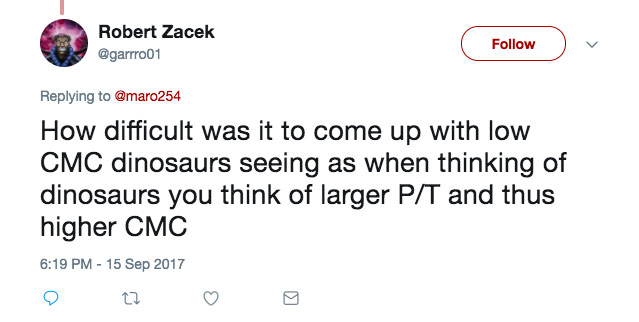
One of the problems we had when making Dragons of Tarkir was that whenever we made a creature a little too small, it stopped feeling like a Dragon. We didn't have that problem with Dinosaurs, as there are many iconic smaller Dinosaurs. For example, velociraptors are a major player in popular culture. Dinosaurs also had the advantage that they come in both flying and non-flying forms. (See last week for my discussion on the scientific accuracy of flying Dinosaurs.)
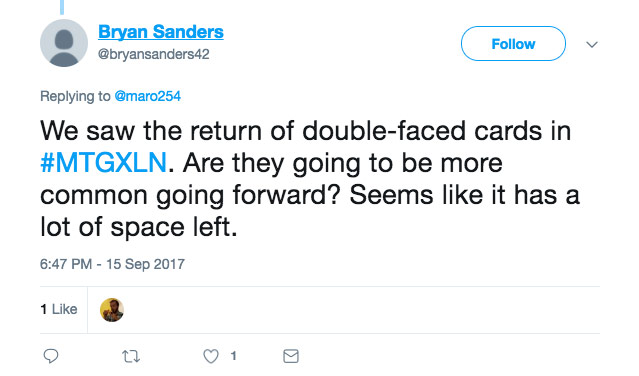
I've been pleasantly surprised by how much design space there is in double-faced cards. In fact, it's become a running joke that every set has something that could be turned into double-faced cards. So why don't do we do that? A couple reasons:
One, they cost extra money to print. Each set has a budget and doing double-faced cards all the time would mean eating up that budget, which would prevent us from trying other cool things.
Two, while the majority of players like double-faced cards, they're not universally popular. There's a minority of players that actively dislikes them. Now, we're willing to make those players put up with double-faced cards every once in a while, as double-faced cards are popular, but doing so every set would be a bit much.
Three, one of the ways to keep something splashy is to exercise some restraint in how often you use it. Double-faced card design has a lot of cool space for us to explore, but we want to use it slowly so that each use can be exciting.
Four, double-faced cards present some logistical issues to players. Yes, we're willing to add them to the game some of the time, but we don't want it to be something that players always have to deal with.
Time's Up
That's all the time I have for today. I want to thank everyone who sent in a question. You all sent in so many (and good ones too), I couldn't get to them all. As always though, I'm eager to hear your feedback on my answers. So, if you have anything to say about what I said, you can send me an email or contact me through any of my social media accounts (Twitter, Tumblr, Google+, and Instagram).
Join me next week when I'll finally share the big changes that have gone on behind the scenes in R&D.
Until then, may you play Ixalan and come up with even more questions.
#478: Artists
#478: Artists
27:36
In this podcast, I talk about how Wizards interacts with our freelance artists.
#479: When to Keyword
#479: When to Keyword
30:29
I am often asked what factors determine when we choose to keyword a mechanic. In this podcast, I talk all about this topic.
- Episode 477 Topical Blend (20.8 MB)
- Episode 476 Hour of Devastation (18.5 MB)
- Episode 475 Giving Input (18.8 MB)

